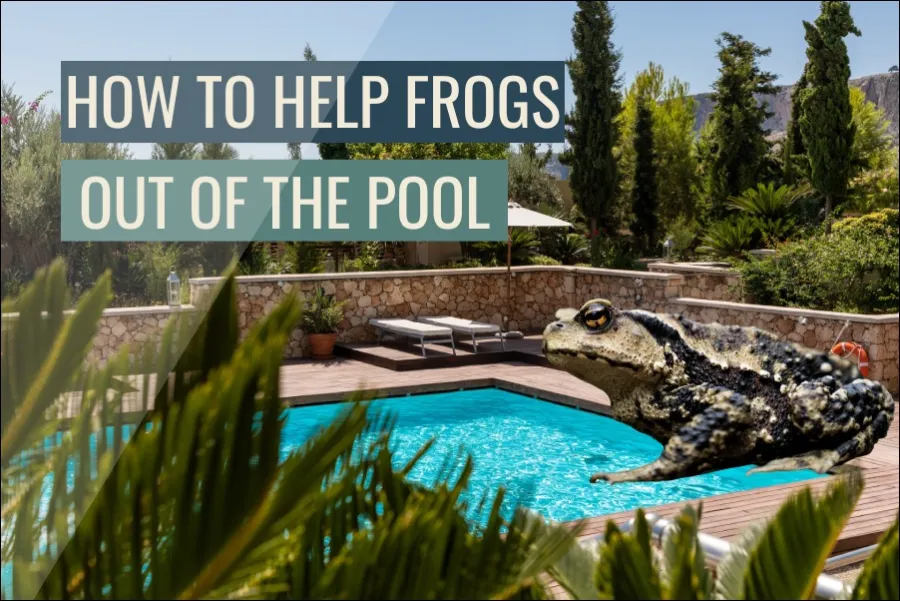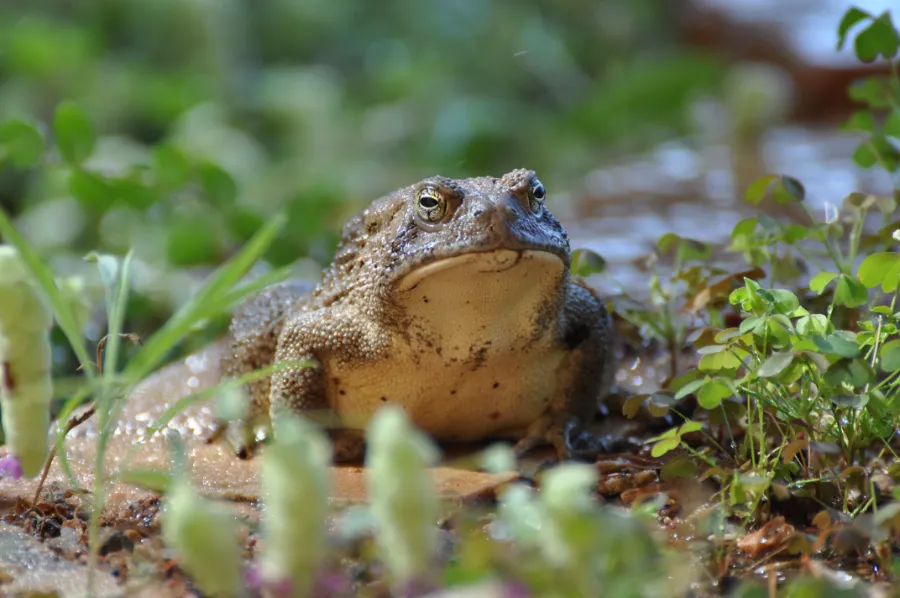
If you have a swimming pool in your backyard, it’s possible that you may occasionally find a frog in the water. While it may be tempting to simply scoop the frog out of the pool and release it back into the wild, it’s important to consider the best way to help the frog safely and effectively get out of the pool.
To help a frog out of the pool, gently scoop it out with a net or bucket. Alternatively, gently pick it up. Avoid squeezing it. Provide a frog ladder or create a frog-friendly environment by covering the pool and providing alternative water sources.
In this article, we’ll explore how to help frogs get out of the pool and the various techniques you can use to do so.
The importance of helping frogs get out of the pool
It’s critical to assist frogs in getting out of the pool since they can drown if they can’t get out. Furthermore, frogs have significant functions in the ecology, acting as indicators of ecosystem health and assisting in insect population management. You can not only save a single frog’s life by assisting them in getting out of the pool, but you can also contribute to the general health and well-being of the ecosystem.
Common reasons why frogs end up in pools
Frogs can end themselves in pools for a number of reasons, including thirst during dry seasons, mistaking the pool for a natural water supply, or falling into the pool accidently. Understanding the common reasons of frog-pool interactions will help you take precautions to avoid them in the first place.
How to safely remove a frog from the pool
If you find a frog in your pool, it’s critical to treat it cautiously and gently to avoid injury. You can scoop the frog out of the water with a net or a bucket, or you can gently pick it up with your hands if you feel comfortable doing so. Avoid gripping or squeezing the frog too tightly, since this might cause harm.
Using a frog ladder or escape ramp
Providing frogs with an escape path, such as a frog ladder or escape ramp, is one approach to assist them in getting out of the pool. These gadgets, which may be installed on the pool’s sides, provide a sloping surface for the frog to climb out of the water.
Creating a frog-friendly pool environment
You may take many actions to make your pool more frog-friendly and less appealing to frogs. Covering your pool while it is not in use, providing alternate water sources for frogs, and avoiding the use of pesticides or chemicals that might kill frogs are all examples.
Providing alternative water sources for frogs
You may make your pool less appealing to frogs by providing alternate water sources for them to sip and bathe in. This can help minimize the number of frogs that wind up in your pool while still providing them with the moisture they require to survive.
The importance of preserving frog habitats
Frog habitat preservation is critical for the health and survival of frog populations, as well as the general health of the ecosystem. You may assist create a more friendly environment for frogs and lessen the probability of their finding up in your pool by maintaining frog habitats.
The role of pesticides and chemicals in frog health
Pesticides and chemicals can affect frogs and have a severe influence on their health. You may provide a safer habitat for frogs and other animals by avoiding the use of these pesticides in your yard and around your pool.
How to prevent frogs from entering the pool in the first place
There are various things you can do to keep frogs out of your pool in the first place. Covering your pool while it is not in use, providing alternate water sources for frogs, and avoiding the use of pesticides or chemicals that might kill frogs are all examples. You may also make your pool less appealing to frogs by eliminating any garbage or plants that could serve as a frog home.
The role of frogs in the ecosystem
Frogs have critical functions in the environment, acting as indicators of ecosystem health and assisting in pest population management. Understanding the worth of frogs and how they contribute to environmental health will help you be more motivated to assist them get out of the pool and protect their habitats.

Should I take the frog out of the pool?
If you see frogs in the pool, it is often a good idea to assist them in getting out. While it may be tempting to quickly scoop the frog out of the pool and release it into the wild, it is critical to evaluate the best approach to do so in order to prevent harming the frog. Here are a few reasons why it is critical to assist frogs in getting out of pools:
- Frogs can drown if they can’t get out of the water. Pools are especially hazardous to frogs because the walls are sometimes too steep or slippery for them to climb out. You can rescue frogs’ lives and save them from drowning by assisting them in getting out of the water.
- Frogs are crucial members of the ecology. Frogs are frequently regarded as keystone species in their ecosystems, which means they have a disproportionately big influence on the environment in comparison to their size. They aid in insect population management, contribute to soil health, and play a part in ecosystem dynamics. You may aid the ecosystem’s general health and well-being by assisting frogs in getting out of the pool.
- Frogs are highly sensitive to changes in their surroundings. Because frogs are sensitive to changes in their environment and can act as an early warning system for problems such as pollution or habitat loss, they are frequently utilized as indicators of ecosystem health. If you discover a frog in your pool, it might be an indicator of bigger environmental concerns, such as habitat loss or deterioration. You may help conserve these critical markers of ecosystem health by assisting frogs in getting out of the pool and protecting their habitats.
As a result, if you see frogs in the pool, it is often a good idea to assist them in getting out. You may help guarantee that frogs can survive and contribute to the health of the ecosystem by following the rules mentioned in this article and taking measures to establish a frog-friendly pool environment.
Can a frog survive chlorine?
Frogs may survive in water with low quantities of chlorine, but excessive levels of chlorine can be poisonous and cause health issues or death. Chlorine is a chemical that is often used in swimming pools to clean them and eliminate bacteria and other impurities in the water. While low quantities of chlorine are typically regarded as safe for people, frogs have sensitive skin and respiratory systems that make them more vulnerable to the effects of chlorine.
High chlorine levels can irritate a frog’s skin and eyes, producing redness, swelling, and inflammation. Chlorine can also harm a frog’s respiratory system, causing difficulty breathing and increased susceptibility to respiratory infections. Chlorine poisoning can kill frogs in extreme circumstances.
As a result, it is critical to keep an eye on the chlorine levels in your pool and ensure that they are within a safe range for frogs. You may test the chlorine levels in your pool using a pool test kit and modify the chemical balance as needed. You may help provide a safe and healthy environment for frogs and other species by keeping adequate chlorine levels and following excellent pool management procedures.
Why do frogs jump into swimming pools?
Frogs may enter swimming pools for a variety of reasons, including:
- Frogs may be drawn to swimming pools in search of water, especially during dry seasons when natural water supplies are sparse.
- Frogs may confuse the pool for a natural body of water, such as a pond or lake, and enter the pool in search of food or a place to mate.
- Accidentally falling into the pool: Frogs may fall into the pool when jumping or climbing, especially if there is trash or plants along the pool’s edge that allows them to enter the water.
- Following prey or evading predators: Frogs may enter the pool when chasing prey or evading predators.
- Understanding the common reasons why frogs enter swimming pools allows you to take preventative measures and create a safer habitat for frogs and other species.
In conclusion
Overall, this article has discussed the numerous methods for assisting frogs in getting out of pools as well as tips for creating a frog-friendly pool environment. You may help frogs’ health and well-being by recognizing their value and the manner in which they contribute to the environment. By following these instructions, you may assist guarantee that frogs can thrive and contribute to environmental health.
